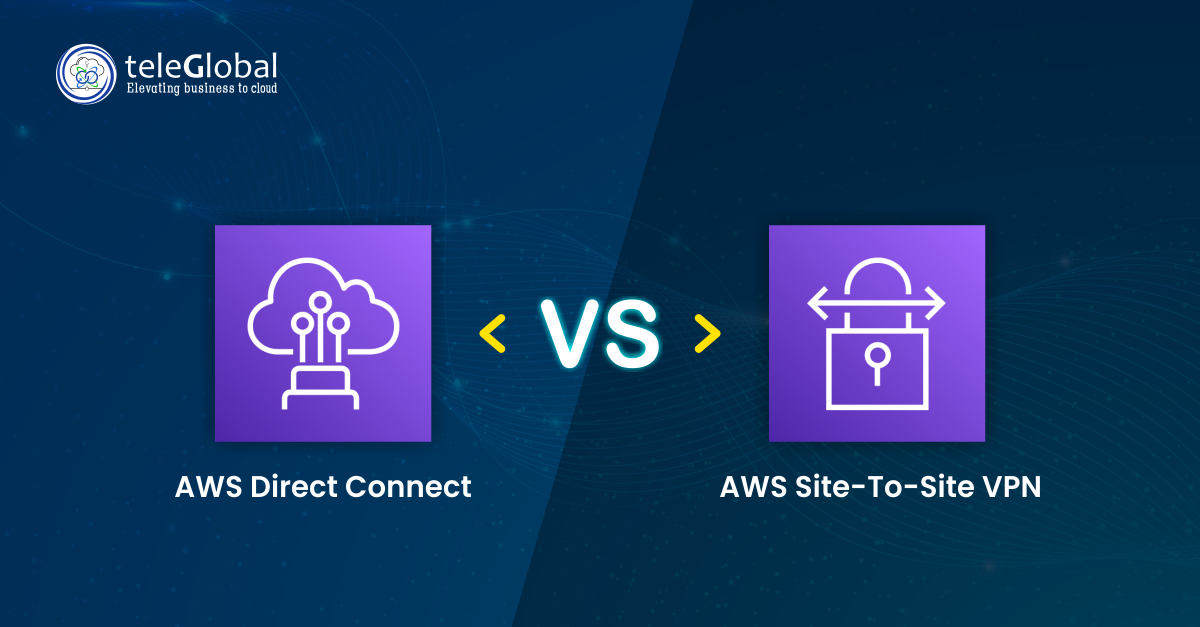
| Author: Kamlesh Kumar | Published: 30-Jan-2023 |
Many companies are adopting hybrid cloud to run critical workloads. It promises scale, flexibility, and stronger performance. But one key challenge remains, how to connect on-premises systems with AWS in a secure and reliable way.
The connection matters. A weak connection can slow your workloads, increase expenses, and even trigger compliance issues. That’s why AWS gives you two clear choices for linking on-premises systems with the cloud: Direct Connect and Site-to-Site VPN.
The real question is which option works best for your business needs. The answer depends on performance goals, budget, and workload type.
In this blog we will explore and compare both AWS services to help you choose the best option for your business requirements.
Companies need a secure way to connect their on-premises networks with AWS cloud. AWS Site-to-Site VPN makes this possible. It creates a protected tunnel over the internet, so data moves safely between your data center and Amazon VPC.
Security is strong. The service uses IPSec encryption to keep data private and unaltered. With this, businesses get a reliable bridge to the cloud without heavy infrastructure.
Still, not every use case needs a complex setup. Site-to-Site VPN works best for startups, testing environments, or teams taking their first steps with AWS networking. It’s a cost-friendly way to connect, learn, and scale later.
Companies often need to link their existing infrastructure with AWS cloud. Doing this over the public internet can raise concerns about security and reliability.
AWS Site-to-Site VPN solves this. It sets up an encrypted tunnel between your on-premises systems and Amazon VPC. Built on IPSec, it keeps data safe and unmodified as it travels.
The service is simple to start with. That’s why it’s a good fit for startups, test setups, or businesses just beginning their AWS cloud journey. It offers a secure and cost-effective path before moving into more advanced networking options.
While both services aim to bridge your on-premises infrastructure with AWS, they use distinct methods to connect your infrastructure. Let’s take look at how they differ:
Direct Connect uses a dedicated private line into AWS. This gives stable performance and predictable bandwidth, ideal for heavy data transfers or real-time apps.
Site-to-Site VPN runs over the public internet. It protects traffic with IPSec encryption, but speed can vary. Network congestion or routing changes may affect performance.
AWS VPN performance taps out at 4 GBPS, a fraction of that achieved by Direct Connect, which starts at 50 MBPS and can reach 100 Gbps
AWS Direct Connect also provides a consistent experience as the network is steady, as compared to AWS VPN where bandwidth and latency fluctuate according to the traffic experienced on the public internet.
AWS VPN doesn’t call for extensive additional hardware, unlike Direct Connect, and thus enjoys a lower price point. In addition, VPN offers optional by-the-connection-hour pricing, which obviously is not possible with AWS Direct Connect.
Being a private connection, AWS Direct Connect doesn’t offer encryption of transit traffic by default. However, AWS VPN operates over the public network and this brings potential security risks. For this reason, VPN provides the option of encryption of your traffic.
AWS VPN also provides redundancy through a second channel. So, should the primary channel fail for any reason, your data will still be accessible through the second channel. This feature is not available on Direct Connect. But, if required, it can be set up—as long as the user’s data safety regulations allow for it.
AWS VPN is ideal for organizations that are new to the AWS cloud and are still finding their feet. AWS VPN is easy and quick to set up, and, as we saw, lighter on the pocket too. However, if you need higher security and stable, consistent network performance, AWS Direct Connect is the solution for you. Installation takes longer and needs the expertise of an experienced team to set up, but the performance is worth the wait.
| Features | AWS Direct Connect | AWS Site-to-site VPN |
| Connectivity Type | Dedicated private line | Public internet with IPsec encryption |
| Bandwidth | Up to 100 Gbps | Up to 4 Gbps (with ECMP) |
| Latency | Low and Consistent | Variable and unpredictable |
| Installation Time | Weeks – requires setup by AWS Partner/ISP | Minutes to Hours – self-service via AWS Console |
| Encryption | Not by default | Encrypted (IPSec) |
| Cost | Higher, long-term savings | Lower Upfront |
| Redundancy | Requires manual configuration | Built-in failover support |
Businesses seeking secure connectivity with ultra-low latency and high bandwidth would do well to opt for AWS Direct Connect. And although it may seem pricier at the outset, what with installation costs, once the connection is established, you will save on data transfer costs thanks to the high and consistent network performance.
AWS Site-to-Site VPN is an excellent choice for businesses new to AWS, as it is fast and relatively easy to set up. But bear in mind that AWS VPN runs over the public Internet, which means bandwidth and, thus, performance is unpredictable. Also, as it runs on the public internet, there are valid security concerns.
For a best-of-both-worlds option, users can combine AWS Direct Connect with AWS Site-to-Site VPN. This solution gives users the security of AWS VPN’s end-to-end IPSec connection. The secure encryption of data flowing through the network combined with the low latency and better bandwidth of AWS Direct Connect creates a much more consistent network experience than internet-based VPN connections.
Another advantage of combining AWS Direct Connect and AWS Site-to-Site VPN is that users can achieve high availability and resiliency of their network by leveraging the benefits of AWS Direct Connect connections for their primary connectivity to AWS. This can be done by establishing AWS Direct Connect connections with an AWS VPN backup. Needless to say, your AWS VPN connection should be able to handle the failover traffic from AWS Direct Connect.
As organizations continue to migrate to the cloud, connectivity between their on-premises infrastructure and AWS cloud is of critical importance. AWS offers two excellent—and distinctively different—solutions for this: AWS Direct Connect and AWS VPN.
While Direct Connect offers a more predictable network experience, allowing you to access your AWS resources with greater bandwidth and lower network costs. However, for businesses that are just starting out on AWS, AWS Site-to-Site VPN offers a quick and easy way to connect and secure your network.
Whether you’re planning a hybrid cloud strategy or upgrading your network, it comes with tough choices. The best path forward depends on balancing performance, compliance, and available resources.
Teleglobal’s AWS-certified team can help. We’ll assess your current environment, design the right solution, and plan a smooth deployment.
